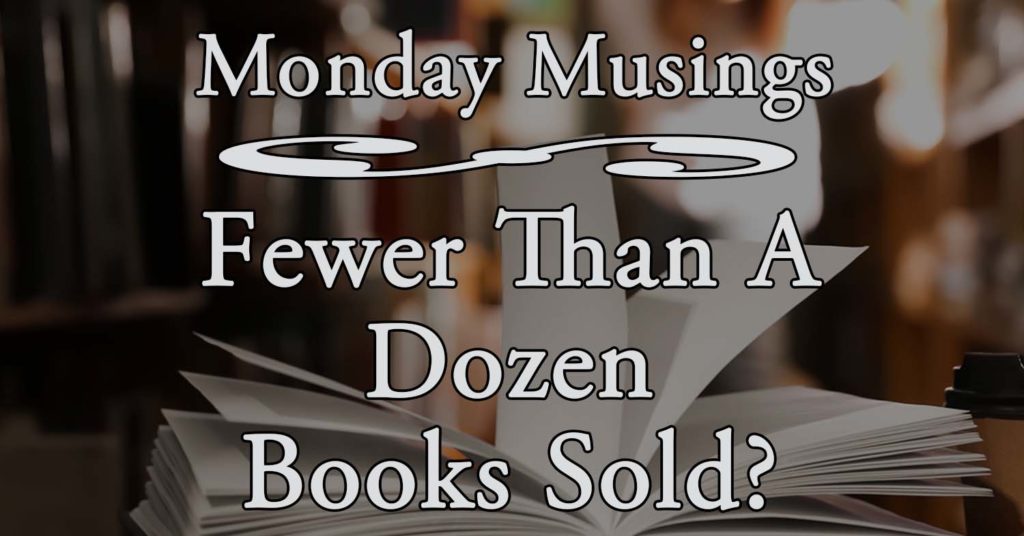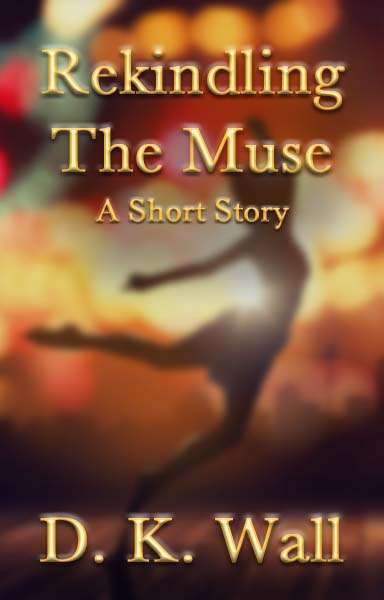Share This Musing
Musing: Fewer Than A Dozen Books Sold?
Of the 58,000 titles sold by the large, traditional publishers each year, only 10% of them will sell more than 2,000 copies in their entire life. In fact, fully half sell fewer than a dozen books. Wait. What? How can that be?
The old 200 copy number
As I’ve shared before, I’ve written stories since I was a kid. Wrote my first novel on pads of paper in high school (Yes, I still have it. No, I will never publish it. It’s awful). And in all my years of traveling for business, I sat in hotel rooms writing at night.
Through it all, I never thought seriously about publishing. I had heard all the horror stories about how hard it was to get an agent, to score a publishing deal, and to keep the deal once you got it. As I shared with my monthly newsletter readers back in June, the scariest statistic I heard when I was contemplating publishing novels was that the average book sells 200 copies in its first year and 1,000 over its lifetime. That doesn’t cover the cost of producing the book, much less give the author any earnings.
The exception, of course, was the holy grail. Land a contract with one of the big publishing houses. The giants of the world. The kings of books. They’re the experts.
Fortunately, I didn’t wait and I’ve beaten that old statistic with every book I’ve published. So maybe, I began to think, it was all a myth. Maybe those averages were wrong. After all, I couldn’t possibly beat the big guys’ averages, right?
So imagine my surprise this week when the latest number came out—fully HALF of the books published by the big publishers sell fewer than a dozen copies. 12.
Where does that statistic come from?
That stunning statistic emerged from the big anti-trust trial. The US Department of Justice is suing to prevent Penguin Random House from acquiring Simon & Schuster and taking the “Big Five” to the “Big Four.” Since the Randy Penguin is already the biggest publisher, this merger would make them dominant. The other three—HarperCollins, Macmillan, and Hachette—combined would barely be bigger than the new entity, so at least one more merger would probably follow.
Fun fact—Penguin Random House is itself a product of a merger between Penguin and Random House just nine years ago. It didn’t take long before that Randy Penguin nickname became common in author circles.
But back to those shocking statistics published in the August 31 edition of the Hot Sheet, a publication by Jane Friedman. In a follow-up Instagram post, Friedman explains a little nuance that makes it slightly better, but not by much.
Without boring you with too many details, the data appears to come from NPD Bookscan who tracks only physical book sales in retail markets. In simple terms, that excludes libraries and the entire ebook market, but includes physical books sold via online retailers like Amazon. Thus, a title might have actually sold more than a dozen copies in all formats, but probably not by much. Large publishers are not known for marketing ebooks well. They normally price ebooks the same as the paperbacks, even though the ebooks obviously don’t have any of the printing cost, a tactic that discourages ebook sales.
So maybe it’s slightly more than a dozen copies in some cases, but that’s still insanity.
But isn’t 58,000 a lot of titles?
While the number may sound huge, 58,000 titles is only a tiny fraction of the more than two million ISBNs (International Standard Book Numbers) registered annually. And that excludes all of the books published without registering for an ISBN. So from that perspective, 58,000 isn’t many at all.
But the average bookstore carries far fewer. They simply don’t have the room for that many titles. The largest bookstores carry more, but many of those titles are from prior years, of course.
To put it succinctly, the easiest path to get a book on the shelf of a local store is through the big publishers, but even they can’t guarantee it. Barnes & Noble, the largest brick and mortar bookseller in the US, understands that which is why they have such a robust online ordering system despite the fact they have some of the largest retail stores.
By the way, another fun fact straight from B&N’s website. Between their online and retail operations, they sell 190 million books a year over a million separate titles (most of those titles are available only online, though you can order them for pickup at their stores). Said another way, on average, they sell 190 copies per title. Obviously, some of those books sell far, far more, so, yes, they probably do sell only 1 or 2 copies through the entire corporation of some titles.
Thus, since those 58,000 titles are just the large publishers and represent only a fraction of the books published each year, you would think their expertise and skill would lend itself to picking the best of the best, right? So why is the result that half of their selections sell fewer than a dozen books?
Believe it or not, it gets worse.
What about the rest?
Of the books that do sell more than a dozen copies, most of those will never sell more than 2,000 in their entire life. A full 90% of the titles published by the big companies fall into that category. To put that into perspective, that is far fewer than a single copy for every bookstore in the U.S.
Which is why they admit that they don’t spend any marketing money on most of their books. The Randy Penguin has revenue of $2.7 billion, yet said in court they spend 2% of that—roughly $55 million—on marketing. Virtually all of that is spent on the top echelon authors.
This is why even the Department of Justice is saying that this merger won’t have any anti-competitive impact on the vast majority of authors. It’s hard to get less than nothing.
So who is affected?
Which brings us to who would really be hurt by this merger. Notice that one of the biggest names in the business, Stephen King, testified against the merger. The big advance dollars go to sure things, books with author names that are more important than the title. Those names may either be successful authors with long track records or celebrities and politicians with high name recognition.
Don’t get me wrong. I don’t begrudge the big names for getting top dollar. I’ve been a fan of Mr. King since I read ‘Salem’s Lot late into the night as a kid. I will always grab his next book. And the same is true of so many other big name authors. They deserve to get paid well because their books sell.
And, yes, I might resent that some celebrities who probably don’t even write their own material get big checks, but some of them put out very entertaining material. Bryan Cranston’s Life in Parts is a great example of fun material from a celebrity.
But the fact is that almost all of these books are published by those five companies. The next tier of companies can’t afford to risk the advance money, so they are gambling on lesser names. And when one of those lesser names succeeds in breaking out, the Big Five swoops in and snatches them up with large advances.
So the fear is that the merger will reduce the competition for this small percentage of successful authors and possibly reduce their negotiating power.
Personally, I don’t think so. Mr. King could write a check and buy one of those publishing companies any time he wanted.
And, remember, Dean Koontz left Penguin for his own deal with Thomas and Mercer, a non-Big Five publisher. I wouldn’t be surprised to see other big names make similar moves. After all, the publishers need them more than they need the publishers.
The good news
So what’s my silver lining?
This is another Wizard of Oz moment. The curtain has been pulled back to reveal the workings of the great and powerful… book publishers. They’re great, if you have a big name. For a lucky few, they can catapult you to stardom.
But for the vast majority of us, who aren’t after fame or fortune, just the opportunity to share our stories, they are a gatekeeper who has become less and less effective at keeping us out because so many other openings exist in the fence.
At the end of the day, only one group really gets to decide if a book is worthy or not. The readers.
And that’s the way it should be.
UPDATE: More Information
The statistic has caused huge consternation in the author world and much debate about its accuracy. A great post by Lincoln Michael challenges the numbers and is well worth the read. Better, though, is a response in the comments from Kristen McLean of Bookscan who tried to replicate the data. You can see her comment there, but the gist is she looked at the new books (ISBNs) published in the last year by the largest 10 publishers and came up with this sales breakdown:
- 0.4% or 163 books sold 100,000 copies or more
- 0.7% or 320 books sold between 50,000-99,999 copies
- 2.2% or 1,015 books sold between 20,000-49,999 copies
- 3.4% or 1,572 books sold between 10,000-19,999 copies
- 5.5% or 2,518 books sold between 5,000-9,999 copies
- 21.6% or 9,863 books sold between 1,000-4,999 copies
- 51.4% or 23,419 sold between 12-999 copies
- 14.7% or 6,701 books sold under 12 copies
While these numbers are different, they still show the largest publishers sell less than 1,000 copies per ISBN in the first year 2/3s of the time. That certainly is different than half sell less than a dozen, but it’s still not a resounding salute to the ability of the big publishers to predict or provide success.
I’m sure more will come, but wanted you to see the whole picture, not just my first blush.
Gratuitous Dog Picture: Running Roscoe

Roscoe P., being the youngest member of The Herd, can’t help when the zoomies hit. He delights in his need for speed and entertains us with his enthusiasm.
On The Website This Week
Vocabulary Word of the Week – Desiccate
July survey results – Who Buys From Bookstores?
The August Survey results and the new September Survey will be posted later this week and linked to in next week’s Monday Musing.
I’m reading a new-to-me author this week. I challenge you to do the same to support all those up-and-coming authors. Feel free to drop me a note or comment and let me know about it. See you next Monday.
5 Comments
Leave a Comment
Subscribe to the Random Musings
Want to be sure never to miss a Musing? Subscribers will be notified when I post a random observations on life or a short story. The email is absolutely FREE and you my unsubscribe at any time.
Current Reader Survey Question
Enjoyed the Story? Try a Short Story
Secrets, passions, and a reunion that changes everything
Benjamin Walsh sees his wife, Nicole, walking down a city street. With her busy schedule at work, he doesn't know how she found time to get away, but tries to catch up to say hello.
To his surprise, she greets an old friend of hers, Eduardo Rivera. Eduardo left town two decades earlier to pursue a theatrical career in New York. What is he doing back?
Benjamin is shocked when Eduardo and Nicole embrace. They disappear through a door together. With understanding of what is happening, Benjamin realizes he has only one choice.
Publication Date: February 6, 2024
Format: E-book (EPUB, MOBI, PDF)
Pages: 38
Price: Pay what you want (Minimum 99¢ to cover processing costs)




As an author, do you make more money off of a print book or an ebook, or is it the same?
It’s a great question which, unfortunately, has a somewhat complex answer. The short answer is ebooks, but the longer answer is it depends on where the paperback is purchased.
Ebooks have the most predictable royalty rate because the only cost is the retailer’s share. Some pay a little better than others, but we’re talking pennies of difference. And there’s no (little) distribution cost because it’s just an electronic file.
Paperbacks, however, are a totally different beast. Printers, distributors, and the retail store itself all take a slice of the pie. To keep the price as reasonable as possible, I end up with a very small share of that sale. I’m okay with that because I want to reach readers and I want to support bookstores, particularly all those indie bookstores out there. (Side note – Publishers pay different percentages of the sales price to the retailer. I pay the maximum 55% of the retail price to support them. Just in case any indie bookstore owners are reading this.)
The other problem with retail paperbacks is that returns are 100% the responsibility of the publisher, not the store. One return costs me the equivalent of 4 sales. Yee-haw.
Anyway, the exception on paperbacks is the giant company itself—Amazon. Because of their size, they cut out the printers and distributors (because they do it themselves) and don’t take the maximum. The end result is that a paperback sold on the Zon results in my best royalty. As much as we all like to grumble about Amazon, they really do take care of authors and I’m thankful.
Told you it was a little complicated.
P.S. – A few notes:
The costs I’m talking about below ignore all the upfront cost of producing a book. A team of three editors work hard to correct my mistakes. A fantastic, professional cover designer creates that image. The book has to be laid out for print and the various ebook formats (yes, of course there isn’t just one). Fortunately for me, all those layoffs from the big publishers means plenty of highly qualified people freelance this work (even for the big publishers). It takes around 1500 copies sold for me to cover that cost. Some authors spend less, but I don’t.
The cost above also excludes my biggest expense—marketing. I run ads continuously to reach an audience and that isn’t cheap. Plus website, newsletter, etc., etc.
Finally, there is the typical administrative cost of running a business. I keep it as lean and mean as possible, but there are other costs.
Once all that is covered, I’d be better off employed, but it’s a labor of love.
Interesting info about books published and actually bought by the public!
Got to LOVE Roscoe P and his ZOOMIES!!!!
The average person isn’t aware of how complicated publishing can be. You’re a loyal artist to your craft.
Roscoe on wheels. He’s a hoot!
Cute little Roscoe is glad of all you go thru to put kibble in the bowl.